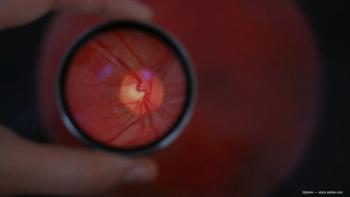
OCT takes on evolving role in neuro-ophthalmology
Optical coherence tomography increasingly helps neuro-ophthalmologists to localize the location of damage, make a diagnosis, and assess treatment.
Reviewed by Randy Kardon, MD, PhD
Iowa City, IA-Optical coherence tomography (OCT) plays a growing role in neuro-ophthalmology, said Randy Kardon, MD, PhD.
“We’re using it much more to fine-tune and localize where damage is, nail down the diagnosis, give a prognosis of visual recovery, and to assess treatment,” said Dr. Kardon, professor and director of neuro-ophthalmology; director of the Iowa City VA Center for Prevention and Treatment of Visual Loss; and Pomerantz Family Chair in Ophthalmology, Department of Ophthalmology and Visual Sciences, University of Iowa, Iowa City.
SPONSORED: Join us for dinner and diabetic eye disease strategies!
For these reasons, OCT has become more common in the offices of neuro-ophthalmologists.
Cerebral angiogram revealed posterior cerebral artery aneurysm. Left: Pre-treatment. Right: Posttreatment coiling (Images courtesy of Randy Kardon, MD, PhD)Case in point
Dr. Kardon shared the important role that OCT played with a recent patient he saw, a 55-year-old man who had lost his right eye in a car accident in 1977.
The man was asymptomatic in his left eye, and the ophthalmologist who had seen him thought the patient had some cupping of the optic nerve, raising the suspicion of glaucoma. IOP was below 15 mm Hg, and visual acuity was normal. The patient’s visual field exam showed a very minor decrease in light sensitivity at a few locations, but an OCT of the optic nerve showed thinning of the neuroretinal rim.
Related:
A ganglion cell layer analysis showed normal thickness on the temporal retina, but significant thinning on the nasal retina that seemed to respect the vertical meridian.
“You start to worry about something in an intracranial location,” Dr. Kardon said.
The patient had an MRI of the brain, which showed a normal pituitary gland and a small little nodule next to the chiasm that enhanced with contrast.
The patient was then sent for an angiogram, and he was found to have an aneurysm in the posterior cerebral artery. He was treated with coiling as an outpatient and went home the same day.
Making a difference
“So here’s an example of a 1-second OCT on someone you thought had nothing in the brain, and something was uncovered,” he said. “If that were not picked up, he could have died of a ruptured aneurysm.”
Recent:
Another way that OCT is benefiting neuro-ophthalmology is to obtain a closer look at thinning of the ganglion cell layer, which is found in 20% of veterans who have traumatic brain injury, according to recent research from Dr. Kardon.
The technology also can be combined with enface analysis and be used to better diagnose papilledema.
Patterns of retinal ganglion cell layer thinning. A. Chiasmal disorders
Patterns of retinal ganglion cell layer thinning. B: Optic tract lesions
OCT quantification of papilledema grade. (Images courtesy of Randy Kardon, MD, PhD)Although OCT helps neuro-ophthalmologists to diagnosis more severe cases, it also can help find cases that can be treated within the office. Dr. Kardon shared the story of a patient with a unilateral temporal visual field defect. OCT imaging revealed retinal thinning in the outer retina corresponding to the location of the visual field defect who had degeneration of the photoreceptors due to acute zonal occult outer retinopathy.
Recent:
“With the temporal visual field loss, we would normally send this patient out for a scan,” Dr. Kardon said. “But with the results of her OCT, we were able keep this patient in the office, avoid having to obtain a brain MRI, and make the correct diagnosis. This shows how the technology can work both ways.”
More:
Randy Kardon, MD, PhD
This article was adapted from Dr. Kardon’s presentation at the 2015 meeting of the American Academy of Ophthalmology. He did not indicate any proprietary interest in the subject matter.
Newsletter
Don’t miss out—get Ophthalmology Times updates on the latest clinical advancements and expert interviews, straight to your inbox.








































